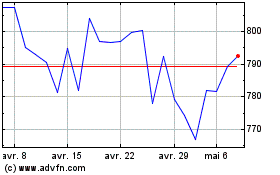For Luxury Retail Real Estate, Paris Retains Its Je Ne Sais Quoi
02 Juillet 2018 - 1:29PM
Dow Jones News
By Isobel Lee
One of the few bright spots in retail real estate these days is
on the so-called "high streets" of major cities, where luxury
brands are still willing to pay stratospheric rents to promote
their designer clothes, accessories, shoes and other goods.
Nowhere is the luxury high street stronger today than in
Paris.
The French capital saw more luxury store openings than any other
city in the world last year, accounting for 5.6% of total global
designer store launches, according to real-estate firm Savills.
In October, Louis Vuitton opened its new flagship on Place
Vendôme, in a historic property near the Ritz hotel that was
originally built by the architect behind Versailles. Designed by
Peter Marino, the store is a maze of art-lined rooms, with space
for private appointments as well as for Instagrammers looking to
snap the latest products from creative director Nicolas
Ghesquière.
Nearby, luxury rival Chanel has slowly been acquiring smaller
premises around its historic home at 31 Rue Cambon over the past
decade, with plans to create the brand's largest store in Paris, if
not Europe. Set to open later this year, the revamped flagship will
include offices, showrooms and museum spaces, as well as workshops
for customizing goods.
The decision by both Vuitton and Chanel to buy property instead
of renting reflects a long-term commitment to physical stores, said
Faustine Godbert, an associate in Savills' retail real-estate unit
in Paris. "Luxury brands are ready to pay huge amounts to own the
building, because they know that they will stay there for a long
time," she said.
The investments reflect the diverging paths of retail brands,
with luxury labels buoyed by Chinese consumers even as the sector
overall remains under siege from online competition. While sales at
some high-end stores may not be enough to justify their high
real-estate costs, retailers still consider the locations
invaluable for marketing and branding purposes.
For Paris, a position atop the high-street heap underscores the
city's re-emergence as a fashion and tourist mecca nearly three
years after terrorist attacks caused visitor numbers to plummet,
decimating retail turnover.
"When the hotels are full, so are the boutiques," said Ms.
Godbert. "International tourism is a more important driver of
luxury retail sales now than ever before. And the fashion houses
are ready to welcome them in a big way."
Asian shoppers, in particular, have been helping the city's
retailers. "Paris welcomes more Chinese overnight visitors than any
other European city," says Marie Hickley, director of Savills
European retail research. They come for cheaper prices than they
can find in their home markets, and to be certain they're not
acquiring fake goods, she said.
Landlords are reaping the benefits. Prime high-street Paris
rents grew about 9% a year between 2013 and 2017, according to Rob
Wilkinson, chief executive of AEW Europe SA, a unit of asset
manager AEW Global. "But it's very much bifurcated between high-end
luxury and the more basic retail that's been impacted by
e-commerce," he added.
Some investors have been taking advantage of the high prices to
put properties up for sale. New York-based Thor Equities LLC, which
has accumulated a half-dozen Paris properties in recent years, sold
two flagship spaces on Rue de Rennes last week. It also recently
sold a designer arcade on the Croisette in Cannes, leased to
Burberry, Bottega Veneta and Saint Laurent, among others.
Not all high streets are experiencing the same boom. In New
York, rents along the toniest section of Fifth Avenue fell to
$3,700 a square foot in the first quarter of 2018, down 0.5% from
the same period a year earlier, according to CBRE Group Inc.
And while luxury brands have proved more resistant to online
competition than their peers, that could change. By 2025, as much
as 25% of luxury goods could be sold online, according to a report
from Bain & Co.
Paris, or course, has been a fashion and retail hub for
centuries. Louis XIV's finance minister, Jean-Baptiste Colbert,
famously quipped in 1665 that "fashion is to France what the gold
mines of Peru are to Spain." But in the past quarter-century, the
look of and feel of luxury shopping in the French capital has
changed.
Luxury brands have colonized new arrondissements -- perhaps most
successfully in the Marais, says Veronique Nocquet, head of retail
services JLL France. And famed shopping streets have been updated,
with Hermès converting a 1930s swimming pool into a cavernous store
in Saint-Germain-des-Prés seven years ago, and Kering's Balenciaga
and LVMH Moët Hennessy Louis Vuitton's Dior recently opening new
stores on Avenue Montaigne.
"The look of the new flagships has become almost as important as
the product," says Ms. Godbert, of Savills. "And they're an
essential part of a multichannel strategy."
(END) Dow Jones Newswires
July 02, 2018 07:14 ET (11:14 GMT)
Copyright (c) 2018 Dow Jones & Company, Inc.
Lvmh Moet Hennessy Louis... (EU:MC)
Graphique Historique de l'Action
De Mar 2024 à Avr 2024

Lvmh Moet Hennessy Louis... (EU:MC)
Graphique Historique de l'Action
De Avr 2023 à Avr 2024
